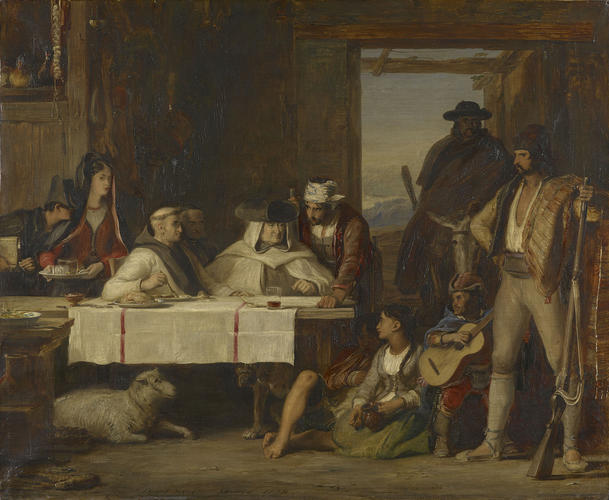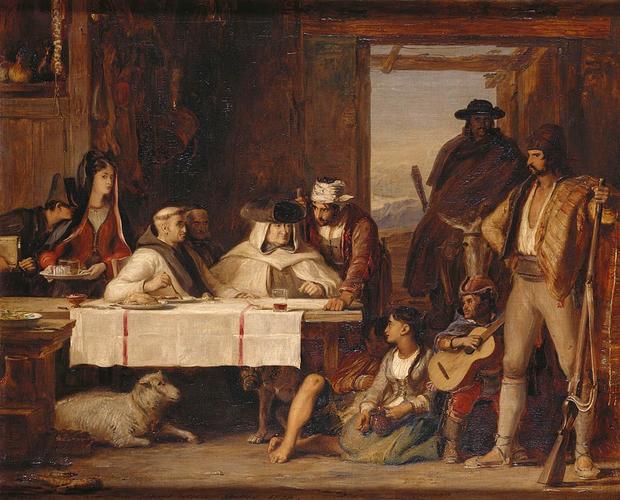The Spanish Posada: A Guerilla Council of War Signed and dated 1828
Oil on canvas | 76.2 x 93.5 cm (support, canvas/panel/stretcher external) | RCIN 405094
-
David Wilkie was one of the most successful painters of the Regency period and was greatly encouraged by the Regent. Born in Fife, trained in Edinburgh, Wilkie settled in London in 1805 and began regularly exhibiting at the Royal Academy small scale scenes of everyday life. At this time old master genre painting was hugely popular and expensive, as is demonstrated by the many examples of the work of Teniers and van Ostade (Adriaen and Isaac) collected at this time by George IV. Wilkie consciously emulated these low-life scenes, charging similarly high prices, but the meaning of his work shifts with the tide of British culture in the later eighteenth century towards a more celebratory (some would say sentimental) treatment of ordinary people. Teniers painted ‘peasants’; Wilkie painted the ‘the salt of the earth’. Wilkie’s royal career involved succeeding Raeburn as Limner to the King in Scotland in 1823 and Lawrence as Principal Painter in Ordinary to the King in 1830; he remained in these positions until his death, although Queen Victoria disliked his work.
In July 1825 Wilkie set off for an extended visit to the continent, taking in Italy and Spain and even a visit to Delacroix in Paris. George IV acquired six paintings (OM 1177-2, 405861, 405091-4 and 405096) from Wilkie following his return to London in 1828. This group of two pairs and two ‘singletons’ has considerable coherence and is characteristic of this period of art in general. This is the age during which Spain was ‘discovered’ by writers and artists as was the Italy of modern life as opposed ancient remains. This was also a period during which the priests, ceremonies and superstitions of the Catholic Church appeared in a good light, by comparison with the godless rationalism of the recently-overthrown armies of the French Revolution. Wilkie’s paintings all depict picturesque life in Italy and Spain, in which faith plays a central part; this is one of four depicting the Spanish struggle against Napoleon’s invaders during the Peninsular War (1808-14). Wilkie also changed his style during this period, taking the oil-sketches of Rubens as his model, rather than the genre paintings of Teniers, to create something grander, sketchier and more rhetorical.
This was the first of Wilkie’s Spanish pictures: it depicts a council of war in a remote inn (‘Posada’). The central episode presents three priests (a Dominican, a monk from the Escorial and a Jesuit) plotting with two guerillas (one leaning over the monk’s shoulder and the other standing to the right). This core episode is interspersed with Spanish ‘local colour’: a student flirts with the landlady; a smuggler rides in the door on a donkey and a person with dwarfism plays a guitar next to a young girl and a goat-herd. The man with dwarfism is clearly intended as a tribute to the art of Velázquez. Everything about this picturesque scene of noble mountain banditry is reasonably easy to interpret, except for the role played by the monks. Catholic priests encouraging terrorism isn’t something automatically admired in British culture. Is there irony intended in the way in which they are so royally treated, with food, wine and white table-cloth?
Signed and dated: 'David Wilkie. Madrid 1828.'Provenance
Purchased by George IV; added to the inventory of Carlton House dated 1819 (no 635); recorded in the 'Wilkie Bedroom' at Buckingham Palace in 1858
-
Creator(s)
Acquirer(s)
-
Medium and techniques
Oil on canvas
Measurements
76.2 x 93.5 cm (support, canvas/panel/stretcher external)
75.1 x 91.8 cm (support (etc), excluding additions)
121.6 x 138.8 x 14.2 cm (frame, external)
Category
Object type(s)










